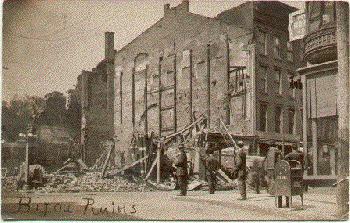Encyclopedia Dubuque
"Encyclopedia Dubuque is the online authority for all things Dubuque, written by the people who know the city best.”
Marshall Cohen—researcher and producer, CNN
Affiliated with the Local History Network of the State Historical Society of Iowa, and the Iowa Museum Association.
BIJOU THEATER
BIJOU THEATER. The Bijou was a famed Dubuque theater located on the northwest corner of Fourth and Main STREETS. A successor to the COATES OPERA HOUSE, the theater's location had been the site of BARTELL'S DRAMATIC AND VAUDEVILLE THEATRE in the 1890s and the ATHANAEUM. A performance of Edwin Booth and Lawrence Barrett in 1888 led to Dubuque's first auction of choice seating to those who did not wish to stand in line for tickets. Much to the surprise of those sponsoring the auction, the auction raised a disappointing $471.25, only $47.75 more than the regular price of admission.
The Bijou came into existence in 1904 when Jacob Rosenthal, of Siegfried and Rosenthal of Omaha, Nebraska, took over the management. Under Rosenthal, the Bijou became a vaudeville house with its opening night November 14, 1904. From then until June 1905, the theater daily presented a two-hour afternoon and two-hour evening performance with an admission price of ten cents. Six musical numbers were presented at each performance.
In 1909 the Dubuque Opera House Company was incorporated and purchased control of the theater. Extensive remodeling began almost immediately. The stage was lowered from the second to the first floor, and four box seats were installed on each side of the expanded stage. The horseshoe-shaped gallery was often the scene of verbal exchanges between the "Packing House Row" on one side and the "Dutchtown Gang" on the opposite side. (1)
The completed theater, considered one of Iowa's most beautiful, was destroyed by fire on April 7, 1910. Firemen discovered smoke coming from under the stage door. The origin of the blaze which resulted in $60,000 in damages, was never determined.
The theater owners, Rosenthal and Spensley, announced immediately that architects would be arriving the following week to draw plans for a "larger and grander" theater. (2) The actors and actresses who were left unemployed and in loss of their costumes by the fire sold tickets to a benefit that was arranged to help them re-establish their acts. Actors from out of town were also expected to return to Dubuque to entertain and raise money.
The site was soon the location of the MAJESTIC THEATRE.
---
Source:
1. "He Wore Gold Coins in His Vest," Telegraph Herald, October 17, 1937, p. 7
2. "Dubuque Will Have New Bijou," Telegraph Herald, April 9, 1910, p. 3




